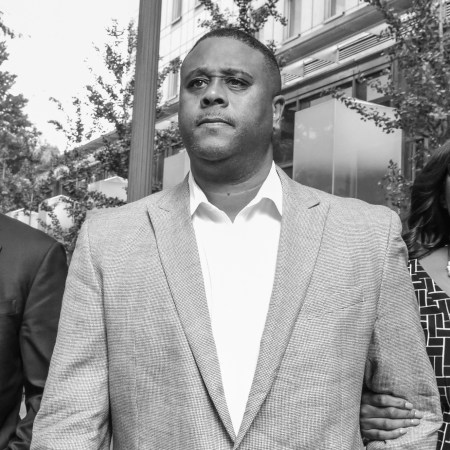Leaving Tribeca that Monday, May 6, 2019, he probably drove a dozen blocks north and then hung a left just before the New York City Fire Museum. After no more than five minutes in the Holland Tunnel, inching under the Hudson River towards New Jersey, the inclination was probably to speed, as one often does in New York, more out of self-preservation than anything else. But he would have been in no rush. Another few turns and the crestfallen man with graying hair would enter the throng on I-95. Then another left, this time onto I-80, where eventually his driver snaked the car northwest onto 17, passing through Paramus, Mahwah, Ramapo. Then a sharp swing west, merging onto US-6 just before Woodbury Commons. This was New York, sure, but well beyond City borders. Zooming past Goosepond Mountain State Park, he was, we may suppose, holding back nausea. With Goshen off to the right, he crossed into Orange County — nearly the homestretch. So green and quiet, far from the bustle and stink of Manhattan. Left onto Mt. Hope Road. There’s Otisville Elementary. After the cemetery, the driver banked right. Wouldn’t be long now. Middle of town — nail salon, post office, hardware store. At 2 Mile Drive, the car took another hard right, so hard it seemed like a U-turn. It’s just trees on all sides, but it was likely hard to appreciate the beauty. At the end of the road was a loop, but the passenger wasn’t a visitor, and he would not be taking the return trip. He would not, in fact, see the City again for a while. Barring a pardon, anyway.
At the entrance to FCI Otisville, a medium security federal prison, Michael Cohen, Donald Trump’s former attorney, removed his jacket. He was on his own, and the entire facility was under lockdown. “Guys in the medium, the J-Unit and the camp were all confined to their beds for 24 hours,” wrote a former inmate. “I heard they were not happy.”
Once processed, Cohen was taken to the minimum-security satellite, known colloquially as “the camp.” The camp, and not the fenced-in medium-security facility housing 625 inmates, is what Forbes meant when it deemed Otisville “America’s cushiest prison.” It’s a breezy designation, easily bestowed by clickbait artists on the outside. That said: It is true there are no fences or bars, but reportedly a yellow line inmates are encouraged not to cross. Sure, a man could escape, and it has happened, but there’s little incentive. Escapees are inevitably shipped off to a worse place in Pennsylvania, Florida, Texas, California, maybe Oregon.
The freedom, then, is relative and conditional. But for Cohen, requesting the camp late last year was a no-brainer. He’s an observant Jew — with a strange disregard for the Ten Commandments, to be sure — and Otisville is, for the people of the book, as good as it gets.
Certain correctional facilities have what might charitably be considered specialties: Butner’s medical center; Milan’s diploma program; the various prisons across the country with sex-offender treatment programs. So why shouldn’t there be a preferred institution for observant landsmen?
At a glance, Otisville resembles any one of the country’s minimum-security camps. Inmates tend to be white collar and low risk, and have incurred sentences of under 10 years. As a consequence, there is relatively little violence. (A recent audit of sexual violence exists, but the firm responsible for it declined to provide camp-specific results.) An occasional fistfight, perhaps. “You’re most likely not going to get stabbed,” says Michael Frantz, a prison consultant. “But when you’re sleeping at night, you can get two or three people in there pouring urine and feces all over you and slugging you.”
Breakfast is served at 6:00 a.m., and an hour later on weekends and holidays. “All food service meals must be consumed in the dining room,” according to the handbook. “You are not allowed to take any portion of the main line meals to your living quarter.” Afterwards, the 120 inmates can walk around, exercise at the track, play softball. Maybe they’ll play billiards, watch television, visit the library or attend a class on anger management. Lunch is at 11:00 a.m., and over by noon. At intervals, inmates stand out in the hall for a headcount. At night, one or two guards walk around.

“A federal prison camp is terribly boring,” Frantz tells InsideHook. “There’s absolutely nothing to do.”
In that respect, too, Otisville is no different. But unlike the others, a significant amount of the camp’s inmates, reportedly more than half, are Jews. In other words, there’s always a vital quorum of 10 adult men necessary for worship. Indeed, steps were taken to ensure that was so. “In case we were ever short, there were certain members of the Jewish community who weren’t personally observant, but would attend just to ensure that we had a minyan,” says O.T. Seville, a former investor who wrote a pseudonymous memoir about his 10-month bid at Otisville. (I have maintained Seville’s pseudonym as a favor to his wife.)
There is also a full-time Hasidic chaplain, noted The Forward, as well as kosher vending machines, the freedom to wear zizit and Shabbat services. Whereas a gentile might be allowed a furlough on Christmas, the men of Otisville may leave the premises for Passover and a mikveh — a ritual bath — in nearby Ellenville or Middletown. The chaplain, Rabbi Avrohom Richter, is the director of Chabad of Howard Beach, and has the political clout to call in a favor of Senator Kirsten Gillibrand.
The camp’s kosher food, the quality of which often gets touted in the press, is not spoken of fondly by former inmates. “Everybody thinks that because it’s a camp, the food is better. For the religious Jews, the food is not much better,” says one, now living on the straight and narrow in Brooklyn. According to him, inmates were served Meal Mart. “It was prepackaged, like airplane food.” Sabbath meals, however, were somewhat better because the men had access to a kosher kitchen and oils, sodas and bottled water (as well as gefilte fish, rugelach and matzo ball soup) from commissary.
Certain well-connected inmates were rumored to have paid a decent caterer on the outside for better meals than the BOP was willing to provide. “It was, let’s say, very unofficial, because it’s illegal,” says Seville.
In any case: Why, and how, did FCI Otisville become a sought-after correctional institution for Jewish convicts?
“The BOP didn’t build that facility and say, ‘Hey, we’re going to house a large number of Jews here,’” says Frantz. Indeed, in 1976, when plans for the first correctional facility in New York State were announced, press accounts were vague about the inmates slated for the tract of land in Orange County that had, at various points, been a rehab center, an Army hospital and a tuberculosis sanitarium. “The prison will be a minimum-security “campus-like” compound for 500 “white-collar” criminals,” reported the New York Times.
A definitive answer to the question of Otisville’s relative hospitality is probably beyond reach, but here’s a scenario: the origins may be in a lawsuit filed by the late Israeli-American terrorist, Meir Kahane. In 1975, while serving a one-year sentence at a federal minimum-security prison in Allenwood, Pennsylvania, the ultra-nationalist rabbi sued for the right to kosher meals. A federal judge ruled that the Bureau of Prisons could not, in fact, deny Kahane food in keeping with his religious dietary restrictions. Allenwood, however, refused to comply, and Kahane was transferred to a hotel on the west side of Manhattan. Then, in 1978, the year after Otisville opened for business, an inmate at Greenhaven prison, an hour east, became the first New York state prisoner to be served kosher food. (To this day, Greenhaven operates a Hot Kosher Food program.) Once Otisville received a group of Satmar inmates, who came with their own dietary requirements, the BOP — rather than order a system-wide adherence to Jewish law — informally chose Otisville to be in compliance.
Once that happened, herd behavior took over; Jews wanted to be with like-minded individuals.
Which is how, in a roundabout way, Michael Cohen ended up requesting to be sent to a little town 70 miles northwest of Manhattan.
Even on his best day, Cohen has always seemed hapless. This is a man whose credibility was somehow undermined by that paragon of integrity, Sean Hannity. However, the past is not prologue, and just because Cohen was a punching bag on the outside doesn’t mean he couldn’t develop a more respectable, less humiliating persona inside. In some precincts, though, it’s taken for granted that Cohen will be targeted by fellow inmates for being a turncoat, and indeed may be in some unspecified danger. “He should bring his prayer book,” an ex-inmate told the New York Observer. “He’s probably the most high-profile rat that Otisville has ever had.” “There is no way that Cohen makes it through prison without having all kinds of problems,” an inmate at FCI Terre Haute told Vice.
That is, I think, almost certainly wrong, and a misunderstanding of the camp population. As Seville put it recently, “First of all, nearly everybody was a rat. Because generally speaking, rats got more early release to a halfway house, things like that. So I would not say that they are discriminated against.”
Which is not to say Cohen would command respect. But he could certainly be useful. David Schick, for instance, was a Brooklyn lawyer who allegedly scammed investors out of $200 million. After he was sent to Otisville in 2005, Schick would approach new inmates and ask, “What do you need?” While sitting in his bunk, wrote David Sarna in History of Greed, Schick provided legal counsel without charge. He was, according to Sarna, the “king of Otisville.”
Indications are that Cohen, well into the first year of a three-year sentence, is doing reasonably well. He’s working on a book. Inmates, reports CNN, have indeed approached him for legal advice. He had his first Sabbath meal, of “gefilte fish with horseradish, one cup of chicken noodle soup, sliced challah bread, two slices of noodle or potato kugel, and dips for the sliced challah.” But he “hates the food,” apparently, and has already lost more than 30 pounds.
Personally, I want to know how Cohen endured the Days of Awe — the 10 days beginning with Rosh Hashanah and ending with Yom Kippur. In an environment of constant stress, this period, during which inmates intermittently fast, is one of heightened tensions. “The High Holy Days are long, even on the outside,” notes Lawrence Dressler, a former inmate who maintained a prison blog. Because of the mandated deprivation of the computer, the phone and other amenities, Dressler says, “guys can get overwhelmed by all the prayer services and get on each other’s nerves.”
Still, such days do offer pleasures for the body and soul. Did Cohen enjoy the mikveh? Was he joyous as he and his compatriots “lined up and walked down the steps into the bath, dunked their bodies, and then walked out, single file”? A week later, on the Day of Atonement, did he repent for his sins against God?
An email to Cohen’s spokesperson has not been answered.
This article was featured in the InsideHook newsletter. Sign up now.






















